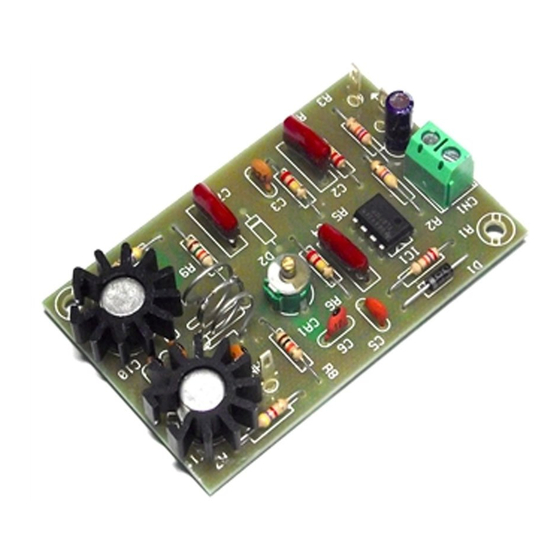
Table of Contents
Advertisement
Quick Links
E L E C T R O N I C C I R C U I T S
EXPERIMENTAL BROADCASTING F.M.
EXPERIMENTAL BROADCASTING F.M.
The FM-2 module is an experimental emitter, specially designed to start in the amateur field. You could emit in the
commercial band from 88 up to 108 MHz. And receive through any radio with F.M band.
It could be connected to a mixer, mixing desk, etc... and supplied from 9 up to 15 VDC. We recommend you our FE-2
power supply or a 12 VDC battery.
It includes protection against polarity inversions and connection terminals.
TECHNICAL CHARACTERISTICS.
Voltage ...................................................................................................... 12 V. D.C. (from 9 up to 15)
Consumption ............................................................................................ 150 mA.
Input Sensitivity ......................................................................................... 300 mV.
Operating Frequency ................................................................................ From 85 to 110 MHz.
Protection Against Polarity Inversions ........................................................ Yes.
Sizes .......................................................................................................... 78 x 45 x 20 mm.
OPERATING.
POWER SUPPLY OF THE MODULE:
Do not use suppliers or rectifiers disturbing the module's operating. Then, we recommended you the FE-2 power supply
which has been developed to perfectly answer to the circuit needs or a 12 VDC Battery for mobile applications.
Install a fuse and a switch as it is indicated in the drawing. Both are necessary and obligatory to assure a correct
module's protection as well as for your own safety as it is indicated in the "CE" regulation.
Connect the positive and the negative of the power supply to the corresponding input indicated in the wiring map. Use
cable as short as possible. Verify that assembly has been correctly done.
ANTENNA CONNECTION:
The distance between module and antenna had to be as short as possible and try to install antenna directly to the
module output. If you have to use cable for this connection, the cable had to be shielded and inferior than 20 cm. Do
not connect module to the power supply if the antenna is not connected to avoid to damage output transistors. The
positive cable of the antenna does not touch the enclosure where the module will be installed.
INSTALATION:
To obtain a correct operating of the module, it has to be installed in a metallic box and the ground has
to be connected.
OPERATING:
To adjust the emitter, use a commercial radio with FM. Place it at 3 m away from the FM-2 module and
adjust the reception between 100 and 104 MHz.
Verify that the antenna is connected to the module and then supply the module. Using a plastic screw- driver adjust the
emission frequency thanks to the trimer. When you listen to a noise from the receiver you had to adjust the receiver till
there is any noise in the receiver.
Then, you could connect the audio input with a signal between 300 mV and 700 mV. If you wish a microphone as input
see the paragraph "How to install a microphone".
The FM-2 circuit had to be supplied by a 12 VDC power supply correctly filtered.
As antenna for our FM-2 module, you could use any metallic rod with a length of 72 cm.
1
FM-2
Advertisement
Table of Contents

Summary of Contents for CEBEK FM-2
- Page 1 OPERATING: To adjust the emitter, use a commercial radio with FM. Place it at 3 m away from the FM-2 module and adjust the reception between 100 and 104 MHz. Verify that the antenna is connected to the module and then supply the module. Using a plastic screw- driver adjust the emission frequency thanks to the trimer.
- Page 2 FM-2 TRIMER (Frequency Adjustment) HOW TO INSTALL A MICROPHONE. L ATERAL To connect a microphone, to our FM-2 module, we suggest MICROPHON'S you to use an electret microphone. Seeing the drawing you VIEW Micro could note that you had to firstly change the C1 capacitor to allow that its negative sign could indicate the negative sign drawn.













Need help?
Do you have a question about the FM-2 and is the answer not in the manual?
Questions and answers